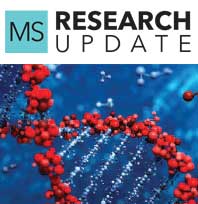Ocrevus® (ocrelizumab)

In this Update
FDA-Approved Medications: Recently Approved
FDA-Approved Medications: New Data on Previously Approved Medications: Infused Medications
Company: Genentech and Roche Pharma AG
- Starting dose: 300 mg given via IV infusion, followed two weeks later by a second 300-mg infusion
- Subsequent doses: 600 mg given via IV infusion every six months
- Approved in 2017 for relapsing forms of MS (RMS) and primary-progressive MS (PPMS)
Previous: Vumerity® (diroximel fumarate) | Next: Tysabri® (natalizumab)
Ocrevus® (ocrelizumab) is a humanized monoclonal antibody, meaning that it is an antibody from a non-human species whose protein sequences have been modified to increase their similarity to antibodies produced naturally in humans. Ocrevus works by destroying the CD20 receptor, a molecule that helps B cells receive messages from throughout the body. Destroying the CD20 depletes the B cells that can trigger neurodegeneration in MS.
A recent study found that people with relapsing-remitting MS (RRMS) who start Ocrevus early and respond to the monoclonal antibody may continue to benefit from the medication many years later. The findings, from an open-label extension of the OPERA I and OPERA II Phase III clinical trials, offer solid evidence for sustained first-line use of Ocrevus in RRMS, researchers said.
During the OPERA trials, Ocrevus showed superiority over an interferon-based medication in slowing disease activity and progression over 96 weeks.25 Patients who completed the 96-week, double-blind comparison trial entered a four-year, open-label extension phase, during which they either stayed with or switched to Ocrevus.
Among patients who switched from the interferon medication to Ocrevus, adjusted annualized relapse rates (ARR) fell from 0.20 in the year before the switch to 0.04 at Year 4 of the open-label phase. Patients who stayed on Ocrevus after the comparison phase also saw a decrease in ARR during the same period, from 0.13 to 0.05.26
Another analysis suggests that early and intensive intervention with Ocrevus may provide meaningful benefit for people with MS who suffer early severe disability.
Researchers performed a post-study analysis of the OPERA I, OPERA II, and ORATORIO trials, in which Ocrevus showed efficacy in slowing disease activity and progression in patients with relapsing-remitting MS over 96 weeks, and in patients with primary-progressive MS (PPMS) over 120 weeks or longer. Drawing on data from those trials, investigators identified 882 patients with baseline Expanded Disability Status Scale (EDSS) scores of 4.0 or greater, 92 patients with baseline EDSS scores >5.0, and 88 patients with baseline EDSS scores >6.0. (On the EDSS scale, a higher score indicates a greater degree of disability.) The patients had received Ocrevus or a comparator – interferon beta-1a in OPERA or placebo in ORATORIO.
The researchers found that the incidence of EDSS score increases over a given 24-week period were significantly lower among patients who received Ocrevus compared with those who received interferon beta-1a or placebo. Ocrevus-treated patients from the ORATORIO trial who had high baseline EDSS scores also saw significant reductions in disability compared with placebo.27
Another team of investigators recently examined the safety of Ocrevus in widespread, “real world” use. Researchers regularly compare clinical trial data on a medication’s safety with data collected after the medication has been approved by the FDA and prescribed by clinicians across the country. The purpose is to ensure that no new “safety signals” or other concerns emerge as a medication that had been tested in hundreds or thousands of patients in clinical trials now is given to a much larger number of people.
In one such study of Ocrevus, researchers analyzed safety outcomes data from the medication’s Phase II and Phase III trials, and from related open-label extension periods and sub-studies. Because length of exposure to Ocrevus varied among participants, rates of adverse events were calculated per 100 patient years, or the number of adverse effects 10 patients would suffer in 10 years.
A total of 4,501 people with MS received Ocrevus in the clinical trials, amounting to 12,559 patient years of exposure. Side-effect rates per 100 patient years were:
- Adverse events: 255
- Serious adverse events: 7.52
- Infections: 77.1
- Serious infections: 2.01
- Malignancies: 0.47
- Adverse events prompting treatment discontinuation: 1.15
Using United States’ claims data and number of vials sold, the researchers then estimated that as of April 2019, 96,000 patients in the general population with MS had received Ocrevus, and that the prevalence of adverse events in this “real world” group is similar to the data reported for the clinical trials group.13
Turning from safety assessments to measures of effectiveness, investigators in the Phase III OPERA I, OPERA II, and ORATORIO clinical trials measured serum and plasma neurofilament light (Nfl) levels in study subjects. Nfl levels are an important marker of disability and disease progression in MS, with those levels tending to be higher in patients experiencing progressive disability than in patients with stable disease.28
After 96 weeks, NfL levels were significantly lower among patients who received Ocrevus relative to levels in the studies’ comparator groups. Among 621 people with either RRMS or PPMS whose baseline NfL levels were above the 90th percentile of normal, a higher proportion of individuals treated with Ocrevus saw their NfL decrease to normal levels, compared with those who received interferon beta-1a (81.4% vs 58.9% in RRMS) or placebo (40.4% vs 16.6% in PPMS). Higher baseline NfL levels also predicted increased disability progression in PPMS, and were linked to worse outcomes for patients with RRMS treated with interferon beta-1a, as evidenced by changes in Expanded Disability Status Scale, Nine-Hole Peg Test, and Timed 25-Foot Walk scores.29
Previous: Vumerity® (diroximel fumarate) | Next: Tysabri® (natalizumab)
